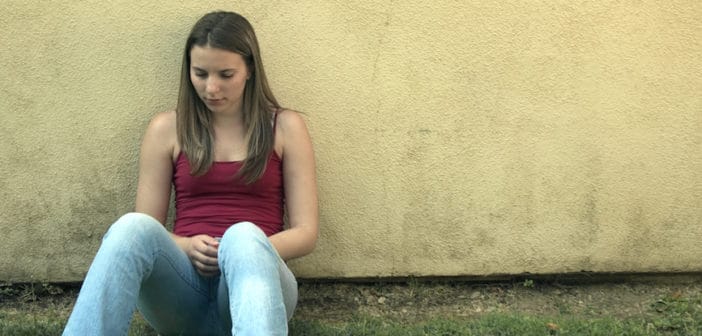 As a teenager, I was a mess of crippling insecurity, raging hormones and horrible fashion choices (white girl dreads anyone?); it was a really dark time for me. I know I’m not alone. In a recent NBC report, researchers revealed some disturbing new statistics about depression in teens. Apparently I was a trendsetter after all, and maybe a lot more normal than I felt. According to the study, conducted by doctors at Johns Hopkins University and published in the journal Pediatrics, major depressive episodes in teens increased from 8.7 percent in 2005 to 11.3 percent in 2014. Not only that, but the fastest growing demographic of depressed teens is white girls.
As a teenager, I was a mess of crippling insecurity, raging hormones and horrible fashion choices (white girl dreads anyone?); it was a really dark time for me. I know I’m not alone. In a recent NBC report, researchers revealed some disturbing new statistics about depression in teens. Apparently I was a trendsetter after all, and maybe a lot more normal than I felt. According to the study, conducted by doctors at Johns Hopkins University and published in the journal Pediatrics, major depressive episodes in teens increased from 8.7 percent in 2005 to 11.3 percent in 2014. Not only that, but the fastest growing demographic of depressed teens is white girls.
Girls, Girls, Girls
Suicide is the third leading cause of death among adolescents and young adults between the ages of 15 and 24. Whites—especially white girls—are the most vulnerable, the study found. It may not be completely clear why, but they have some guesses. Girls mature, in terms of their emotions, faster than boys—and that sensitivity could make them more susceptible to depression and anxiety. That’s a good point, but there may be another reason girls are so depressed these days.
The study suggests that girls, mainly white girls, may be exposed to more potentially distressing things than their peers. Cyberbullying is far more prevalent among teenage girls than boys (anybody who witnessed “the BeyHive” go after Becky with the good hair will probably agree). Also, girls use mobile phones with texting apps more frequently and intensively than boys. Now I’m an adult (allegedly) and I can attest to the fact that waiting for somebody to text me back can result in a raging bout of angst. How are people without a fully-formed prefrontal cortex supposed to handle that shit? The study also reveals that “problematic mobile phone use” among young people has been linked to depressed mood and that’s not even taking into account all the ways Facebook brings us down.
Like, Majorly Depressed
A major depressive episode (MDE) is defined as an extended period of depression lasting two weeks or more. It can include feelings of extreme hopelessness, anxiety, worthlessness and irritability (or as I call it, a Monday). Other symptoms often include problems concentrating, making decisions and thoughts of self-harm or suicide. What’s more unsettling than this list of symptoms is that, even with the increased prevalence of MDE in teens, the rates of mental health treatment have remained the same. This means a bunch of majorly bummed-out kids are suffering and not telling anyone, which is truly depressing.
This trend suggests that not much progress has been made in narrowing the mental health treatment gap for adolescent depression. As if being a depressed teen doesn’t suck bad enough, it has been difficult for doctors to figure out what to do with these patients in the last decade. In 2004, the Food and Drug Administration (FDA) issued a black-box warning on antidepressants indicating that they were associated with an increased risk of suicidal thoughts and behaviors in young people. The hesitance of teens to seek help could have something to do with the reluctance on the part of providers to diagnose and treat depression in the wake of the FDA’s warning.
Back in the Day
I was diagnosed with depression (for the first time) when I was about 15. Without batting an eyelash, my primary care doc put me on the latest and greatest antidepressant—Paxil. Turns out, that particular SSRI drug was being aggressively marketed to doctors treating adolescent depression in the mid 1990s. I’m not surprised to learn this because pretty much everybody I knew was on it. Flash forward to 2012, the manufacturer was fined three billion dollars after pleading guilty to fraud charges. They unlawfully pushed the drug on pediatricians for kids under 18 and published misleading info about its effectiveness on treating depression in young people. Turns out, the only antidepressant drug proven to help depressed teens is good old Prozac. And, even then, heaps of therapy are supposed to accompany any medication prescribed for mental health in teens.
I’m not mad, though. I know now that a lot of the mood swings and depression I was experiencing at the time were likely related to the massive amounts of pot and alcohol I was consuming. But, like the recent report published by the doctors at Johns Hopkins, my experience does illustrate the mess that is adolescent mental health treatment. For many reasons (including shady drug companies misleading everyone and creating a backlash), we live in a culture where young people aren’t getting the mental health care they need. The doctors don’t want to prescribe drugs to teens and teens don’t want to reach out for help. Sadly, even if this new study influences primary care providers to screen more young people for depression, there probably won’t be enough qualified mental health specialists to take care of the million or more adolescents per year, who—if screened and diagnosed—will need treatment and monitoring for depression.
But there’s a silver lining. As more studies and stories like these proliferate, increasing numbers of parents are being enlightened to what may be going on with that surly, pink-haired creature texting during dinner. And with awareness can come a solution. Here’s hoping that we can continue to raise awareness and help more teens get the care they need.
Sponsored DISCLAIMER: This is a paid advertisement for California Behavioral Health, LLC, a CA licensed substance abuse treatment provider and not a service provided by The Fix. Calls to this number are answered by CBH, free and without obligation to the consumer. No one who answers the call receives a fee based upon the consumer’s choice to enter treatment. For additional info on other treatment providers and options visit www.samhsa.gov.




